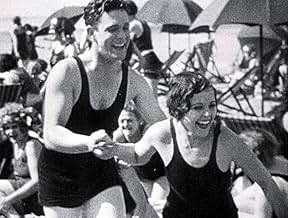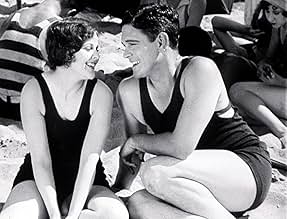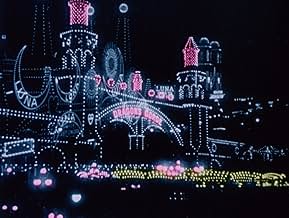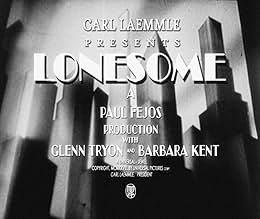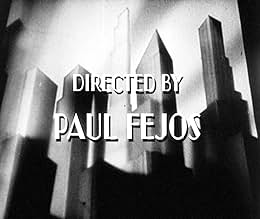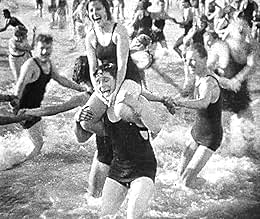Zwei junge Herzen. Eine kleine Episode aus einer grossen Stadt
Originaltitel: Lonesome
IMDb-BEWERTUNG
7,7/10
2818
IHRE BEWERTUNG
Füge eine Handlung in deiner Sprache hinzuTwo lonely people in the big city meet and enjoy the thrills of an amusement park, only to lose each other in the crowd after spending a great day together. Will they ever see each other aga... Alles lesenTwo lonely people in the big city meet and enjoy the thrills of an amusement park, only to lose each other in the crowd after spending a great day together. Will they ever see each other again?Two lonely people in the big city meet and enjoy the thrills of an amusement park, only to lose each other in the crowd after spending a great day together. Will they ever see each other again?
- Auszeichnungen
- 1 wins total
Gusztáv Pártos
- Romantic Gentleman
- (as Gustav Partos)
Henry Armetta
- Ferris wheel guy
- (Nicht genannt)
Edgar Dearing
- Cop
- (Nicht genannt)
Louise Emmons
- Telephone Caller
- (Nicht genannt)
Fred Esmelton
- Swami
- (Nicht genannt)
Jack Raymond
- Barker
- (Nicht genannt)
Churchill Ross
- Telephone Caller
- (Nicht genannt)
Empfohlene Bewertungen
... and I could say the same thing about Fejos' "Broadway", made a year later. Fejos recounts the tale of two lonely New Yorkers, Jim (Glen Tryon) and Mary (Barbara Kent), who find love and each other during a half day holiday at the beach and Coney Island. You first see the workday from Jim and Mary's perspective as they are ruled first by the tyranny of the alarm clock and then the tedium of the workday as you see a clock overlaying the image of each at work. Jim is a low-level machine operator, and Mary is a telephone operator. Then there are "the crowds". Jim and Mary are crowded at breakfast, at a diner filled with patrons, crowded on the subway, crowded at work, and crowded at the beach and amusement park. Yet both of them are completely alone in the world, which, especially in the attractive Miss Kent's case, seems somewhat inconceivable.
This late era silent has a dearth of title cards, which does not subtract from the film's enjoyment. In fact, what does subtract just a little are the short dialogue scenes that just don't make sense. One scene is Jim and Mary on the beach suddenly in the dark AND in color, with the crowd removed. Nothing they say shines any light on their situation or feelings at all. Another one is in a courtroom where Jim has been detained for being unruly. He gives a speech like a Bolshevik basically shaming the judge and ... the judge lets him go???? This social awareness seems very strange stuff coming from Jim who, up to that point, has seemed to be a very uncomplicated fellow. Very strange, but typical of talking scenes inserted into silent films at the dawn of sound.
What is extra special about this film is to see the lives of working class people in 1928. Notice that the workday that Jim and Mary are going through is a Saturday, and this was the norm back then and until some time after WWII. People would normally work half a day on Saturday and have only Sunday in its entirety as a day off. Catch this film if you can, even if you are not a huge silent film buff.
This late era silent has a dearth of title cards, which does not subtract from the film's enjoyment. In fact, what does subtract just a little are the short dialogue scenes that just don't make sense. One scene is Jim and Mary on the beach suddenly in the dark AND in color, with the crowd removed. Nothing they say shines any light on their situation or feelings at all. Another one is in a courtroom where Jim has been detained for being unruly. He gives a speech like a Bolshevik basically shaming the judge and ... the judge lets him go???? This social awareness seems very strange stuff coming from Jim who, up to that point, has seemed to be a very uncomplicated fellow. Very strange, but typical of talking scenes inserted into silent films at the dawn of sound.
What is extra special about this film is to see the lives of working class people in 1928. Notice that the workday that Jim and Mary are going through is a Saturday, and this was the norm back then and until some time after WWII. People would normally work half a day on Saturday and have only Sunday in its entirety as a day off. Catch this film if you can, even if you are not a huge silent film buff.
Even though I have been a silent film enthusiast for 50 years now (I started very young) and have read a number of books on the subject as well as having amassed a rather large collection of silent movies on DVD, I can't remember ever having run across the name of Hungarian born director Paul Fejos. I'm sure there must have been something but I simply can't recall it. After watching this Criterion release, it seems unbelievable that his Hollywood films could have been lost for as long as they were. Two of the three films are welcome additions to the silent film catalog while one is a curious early sound offering. All 3 films on this disc were made for Universal so it's only fitting that they reappear in time for the company's 100th anniversary.
The true prize of the collection is LONESOME, a 1929 film that recalls both SUNRISE and 7th HEAVEN in its storyline and in its cinematic expression of that story. Glenn Tryon (who I knew from some Hal Roach comedy shorts) and Barbara Kent (the sister in FLESH & THE DEVIL) play a pair of lonely blue collar workers who discover each other during a visit to Coney Island. They meet, fall in love, and then are separated by a massive rainstorm without knowing their last names. A simple enough story but it's what Fejos does with the material that makes LONESOME so remarkable. Technically this film goes far beyond SUNRISE in its camerawork and editing resulting in an eye opening cinematic experience that the director called a "Coney Island of the mind".
The other two films on an additional DVD make for an interesting evening. THE LAST PERFORMANCE stars Conrad Veidt as a jealous stage magician whose love for his young assistant (Mary Philbin in her best performance) leads to tragedy. Imagine one of the Tod Browning Lon Chaney films as if it had been directed by F. W. Murnau and that will give you some idea of what it's like. The print used here was found in Denmark and still has Danish title cards. While that proves the universality of silent movies, it would have been nice if new title cards could have been made. The film has also not been restored and is occasionally contrasty and shows some print damage. It's not ideal but is quite serviceable and Conrad Veidt is amazing.
BROADWAY was one of Universal's early sound extravaganzas. It not only features dialogue and musical numbers but it also has an early Technicolor finale. Unless you are really into early sound musicals, BROADWAY is more of historical interest. There are some truly remarkable camera shots courtesy of the "BROADWAY crane" which revolutionized camera movement. The influence on later musicals and Busby Berkeley is obvious. Unfortunately the dialog is incredibly stiff ("Where-is-Steve? He's-in-the-next-room.) and slows down the action. Glenn Tryon is on hand once again as the male lead and it's always great to see Evelyn Brent in anything. This is what THE ARTIST would have been like had it been made in 1929. While this release is an absolute must for silent movie fans others will find it to be of limited interest...For more reviews visit The Capsule Critic.
The true prize of the collection is LONESOME, a 1929 film that recalls both SUNRISE and 7th HEAVEN in its storyline and in its cinematic expression of that story. Glenn Tryon (who I knew from some Hal Roach comedy shorts) and Barbara Kent (the sister in FLESH & THE DEVIL) play a pair of lonely blue collar workers who discover each other during a visit to Coney Island. They meet, fall in love, and then are separated by a massive rainstorm without knowing their last names. A simple enough story but it's what Fejos does with the material that makes LONESOME so remarkable. Technically this film goes far beyond SUNRISE in its camerawork and editing resulting in an eye opening cinematic experience that the director called a "Coney Island of the mind".
The other two films on an additional DVD make for an interesting evening. THE LAST PERFORMANCE stars Conrad Veidt as a jealous stage magician whose love for his young assistant (Mary Philbin in her best performance) leads to tragedy. Imagine one of the Tod Browning Lon Chaney films as if it had been directed by F. W. Murnau and that will give you some idea of what it's like. The print used here was found in Denmark and still has Danish title cards. While that proves the universality of silent movies, it would have been nice if new title cards could have been made. The film has also not been restored and is occasionally contrasty and shows some print damage. It's not ideal but is quite serviceable and Conrad Veidt is amazing.
BROADWAY was one of Universal's early sound extravaganzas. It not only features dialogue and musical numbers but it also has an early Technicolor finale. Unless you are really into early sound musicals, BROADWAY is more of historical interest. There are some truly remarkable camera shots courtesy of the "BROADWAY crane" which revolutionized camera movement. The influence on later musicals and Busby Berkeley is obvious. Unfortunately the dialog is incredibly stiff ("Where-is-Steve? He's-in-the-next-room.) and slows down the action. Glenn Tryon is on hand once again as the male lead and it's always great to see Evelyn Brent in anything. This is what THE ARTIST would have been like had it been made in 1929. While this release is an absolute must for silent movie fans others will find it to be of limited interest...For more reviews visit The Capsule Critic.
Lonesome is like the much more charming, if slightly less ambitious (and at the very end a bit too cute) cousin of Sunrise. It's appeal is in its simplicity, but where Sunrise was about a couple breaking apart and coming back together, this is much more streamlined and less tragic (though it does go for some tragic beats in the last twenty minutes of its slim 70-minute run-time): boy is lonely, girl is lonely, both work working-class jobs (factory/phone operator, what else in New York city in 1928?), they both decide separately after their (so-called!) friends go off on their own adventures to go to the beach and amusement park - is it Coney Island? I can't imagine it being anywhere else - and boy and girl meet as the boy tries to show off doing games. And that's it, that's the movie, and why it stands out (and got a sort-of restoration and Criterion treatment) is its presentation by its director.
I don't know much about Pal (Paul) Fejos except that he directed silent films and somewhat into the 1930's, and then sort of faded away into obscurity. It's a shame since a film like Lonesome shows his talents clearly: he has a keen sense of editing and that way that silent filmmakers sometimes had to super-impose images (perhaps a chip off the Abel Gance block perhaps, but not as ambitious), in particular when he's setting up the hustle/bustle of the city and then later in the film when things get more harrowing with the characters. That is to say when, inevitably, the main conflict is that they are separated in that great sea of people that makes up a massive crowd in a city (where, as the man, Jim, notes at one point, is so strange that you're surrounded by so many but still feel so alone).
The charm in the film comes in how the couple on screen - Barbara Kent and Glenn Tryon - are together; they're kind of like if you had one of those romantic "leads" in those really early Marx brothers movies, only they don't sing and the man is funny in that amusing- lightly- sarcastic way (i.e. bragging about his "six acres on Wall street" at first, which we and the girl knows isn't true, but it's fun to play along). Actually, speaking of that, this is an experimental film at heart for a number of reasons. It appears at first to be a silent film, and for 90% of it it surely is, and is shot like one with that film speed we associate with silent cinema on the whole (that kind of slightly-sped-up speed where its rhythm is distinctly of its cameras and era), and we know this because 10% of the film, more or less, is a *sound* film. No, really, we suddenly move from what is the obvious fluid camera style and wide shots of the crowds and intensity that comes with a camera that moves freely to what is clearly static shots in a studio so the actors are right under a microphone... and the acting is just as static.
That's not totally fair; this is considered, at least according to the trivia, one of the very first films to ever incorporate sound. On that level it's certainly extraordinary and important, but the problem is that it becomes jarring with the rest of the film which is shot with such passion and excitement (it's also frankly weird to hear the actor's speaking voices, whereas before, like I do with a lot of silent movies, I can think of my own voices for the actors that do not sound so... stilted). One of the sound scenes is also one where I wasn't sure if a cop was being sarcastic or not; our man Jim has been taken away by the cops after a roller-coaster ride where Mary, the girl, fainted and had to be taken away but Jim got separated and got rough with a cop. For a moment it seems like he'll be put away, but Jim pours his heart out (with some, I'm sorry, cringe-inducing lines), and the cop's reaction is hard to read since it sounds totally "pfft yeah right"... but then they let him go. Very strange.
But these aren't major complaints for a film that has so much to offer outside of those things. This is a movie that's joy is in its purity, that it's about these two people and how they meet and suddenly all of the usual problems of their everyday lives - the work, the drudgery, the intensity of being around so many people getting on/off the subways or being in the traffic - can float away since they have one another. And there are some moments of experimentation that do work, mostly involving (also, again, a touch of daring with Fejos) color: there's tinted scenes here, which isn't unusual for a silent film, but here it's how the colors are used, over the amusement park scenes to illuminate the lights at night, the performers in the park, the vibrancy that the night off a beach in the city brings.
There are so many moments of rich filmmaking, so much hope that this couple is able to inspire in a short amount of time, and because of the simplicity we're able to invest ourselves into their bond as it gets closer (maybe a little *too* quick, one might want to argue, falling in love within a day), that one can almost forgive a cutesy ending. Almost.
I don't know much about Pal (Paul) Fejos except that he directed silent films and somewhat into the 1930's, and then sort of faded away into obscurity. It's a shame since a film like Lonesome shows his talents clearly: he has a keen sense of editing and that way that silent filmmakers sometimes had to super-impose images (perhaps a chip off the Abel Gance block perhaps, but not as ambitious), in particular when he's setting up the hustle/bustle of the city and then later in the film when things get more harrowing with the characters. That is to say when, inevitably, the main conflict is that they are separated in that great sea of people that makes up a massive crowd in a city (where, as the man, Jim, notes at one point, is so strange that you're surrounded by so many but still feel so alone).
The charm in the film comes in how the couple on screen - Barbara Kent and Glenn Tryon - are together; they're kind of like if you had one of those romantic "leads" in those really early Marx brothers movies, only they don't sing and the man is funny in that amusing- lightly- sarcastic way (i.e. bragging about his "six acres on Wall street" at first, which we and the girl knows isn't true, but it's fun to play along). Actually, speaking of that, this is an experimental film at heart for a number of reasons. It appears at first to be a silent film, and for 90% of it it surely is, and is shot like one with that film speed we associate with silent cinema on the whole (that kind of slightly-sped-up speed where its rhythm is distinctly of its cameras and era), and we know this because 10% of the film, more or less, is a *sound* film. No, really, we suddenly move from what is the obvious fluid camera style and wide shots of the crowds and intensity that comes with a camera that moves freely to what is clearly static shots in a studio so the actors are right under a microphone... and the acting is just as static.
That's not totally fair; this is considered, at least according to the trivia, one of the very first films to ever incorporate sound. On that level it's certainly extraordinary and important, but the problem is that it becomes jarring with the rest of the film which is shot with such passion and excitement (it's also frankly weird to hear the actor's speaking voices, whereas before, like I do with a lot of silent movies, I can think of my own voices for the actors that do not sound so... stilted). One of the sound scenes is also one where I wasn't sure if a cop was being sarcastic or not; our man Jim has been taken away by the cops after a roller-coaster ride where Mary, the girl, fainted and had to be taken away but Jim got separated and got rough with a cop. For a moment it seems like he'll be put away, but Jim pours his heart out (with some, I'm sorry, cringe-inducing lines), and the cop's reaction is hard to read since it sounds totally "pfft yeah right"... but then they let him go. Very strange.
But these aren't major complaints for a film that has so much to offer outside of those things. This is a movie that's joy is in its purity, that it's about these two people and how they meet and suddenly all of the usual problems of their everyday lives - the work, the drudgery, the intensity of being around so many people getting on/off the subways or being in the traffic - can float away since they have one another. And there are some moments of experimentation that do work, mostly involving (also, again, a touch of daring with Fejos) color: there's tinted scenes here, which isn't unusual for a silent film, but here it's how the colors are used, over the amusement park scenes to illuminate the lights at night, the performers in the park, the vibrancy that the night off a beach in the city brings.
There are so many moments of rich filmmaking, so much hope that this couple is able to inspire in a short amount of time, and because of the simplicity we're able to invest ourselves into their bond as it gets closer (maybe a little *too* quick, one might want to argue, falling in love within a day), that one can almost forgive a cutesy ending. Almost.
If only this remarkable movie hadn't had the misfortune to be released just when the enthusiasm for sound was sweeping all before it, it would probably have been more appreciated at the time and remembered today as one of the all-time classics. As an expression of the isolation of city life, it builds up an atmosphere of desperation, in spite of its romance with a happy ending. The scene where the boy searches frantically for the girl throughout crowded Coney Island, buffeted this way and that by the uncaring throngs, turned away by the indifferent faces of the amusement park workers, has few equals for anguish. Also unforgettable is the montage that cuts from one to the other of the lovers (who have not yet met) while they are at work, the one at a factory, the other at a telephone switchboard; the motions of the hands and the machines build to a frantic, overwhelming pace.
Unfortunately, before the movie was released it was sadly mangled by the insertion of several sound sequences, which stop the continuity dead with their absolute stasis, and feature dialogue so thunderously inane you have to suspect it was written by the sound technician. Nonetheless, "Lonesome" remains one of the most sophisticated examples of the silent movie, an art form that was killed by sound almost as soon as it had reached maturity.
Unfortunately, before the movie was released it was sadly mangled by the insertion of several sound sequences, which stop the continuity dead with their absolute stasis, and feature dialogue so thunderously inane you have to suspect it was written by the sound technician. Nonetheless, "Lonesome" remains one of the most sophisticated examples of the silent movie, an art form that was killed by sound almost as soon as it had reached maturity.
...that I cannot stand my own company...says the hero.
This could be the optimistic side of King Vidor's "the crowd".This era was a time when the pursuit of happiness was legitimate and "even with a face like that" you could hope to find the woman of your dreams.Robert Siodmak would make "Menschen Am Sonntag" and Marcel Carné "Nogent Eldorado Du Dimanche" soon after ,and would replace Coney Island by the banks of the Rhine or of the Seine.
1928 was the year before the crash .Even in the biggest city in the world ,you can be lonelier than the loneliest of creatures.He pretends he is a millionaire ,she pretends she is a princess ;in fact he is a working man,she is an operator .
It is not as optimistic as it seems at first sight.The crowds are hostile and do nothing to help them ,they are as selfish as today's crowds .
"Lonesome " is an important movie,if only for its simplicity and its spontaneity.Everything happens in the short space of one day (from the rude awakening to the night when solitude becomes even harder to bear ) and the two principals are really endearing ,almost matching Janet Gaynor and Charles Farrell.
NB:Paul Fejos would continue his career in France in the early thirties where he directed Annabella in a tragic melodrama ("Marie Legende Hongroise")and a remake of Feuillade's "Fantomas", the first third of which surpasses the original .
This could be the optimistic side of King Vidor's "the crowd".This era was a time when the pursuit of happiness was legitimate and "even with a face like that" you could hope to find the woman of your dreams.Robert Siodmak would make "Menschen Am Sonntag" and Marcel Carné "Nogent Eldorado Du Dimanche" soon after ,and would replace Coney Island by the banks of the Rhine or of the Seine.
1928 was the year before the crash .Even in the biggest city in the world ,you can be lonelier than the loneliest of creatures.He pretends he is a millionaire ,she pretends she is a princess ;in fact he is a working man,she is an operator .
It is not as optimistic as it seems at first sight.The crowds are hostile and do nothing to help them ,they are as selfish as today's crowds .
"Lonesome " is an important movie,if only for its simplicity and its spontaneity.Everything happens in the short space of one day (from the rude awakening to the night when solitude becomes even harder to bear ) and the two principals are really endearing ,almost matching Janet Gaynor and Charles Farrell.
NB:Paul Fejos would continue his career in France in the early thirties where he directed Annabella in a tragic melodrama ("Marie Legende Hongroise")and a remake of Feuillade's "Fantomas", the first third of which surpasses the original .
Wusstest du schon
- WissenswertesIt was one of the first motion pictures to have sound and a couple of talking scenes. It was released in both silent and monaural versions. Some scenes in existing original prints of the film are colored with stencils.
- Alternative VersionenProduced in both sound and silent versions. The sound version was 6,785 feet in length, and the silent version was 6,193 feet.
- VerbindungenFeatured in Fejezetek a film történetéböl: Az amerikai film kezdetei (1989)
- SoundtracksAlways
(uncredited)
Written by Irving Berlin
[Played by dance orchestra at ballroom]
Sung by Nick Lucas
[on Brunswick recording played in last scene]
Top-Auswahl
Melde dich zum Bewerten an und greife auf die Watchlist für personalisierte Empfehlungen zu.
- How long is Lonesome?Powered by Alexa
Details
- Laufzeit
- 1 Std. 9 Min.(69 min)
- Sound-Mix
- Seitenverhältnis
- 1.19:1
Zu dieser Seite beitragen
Bearbeitung vorschlagen oder fehlenden Inhalt hinzufügen



